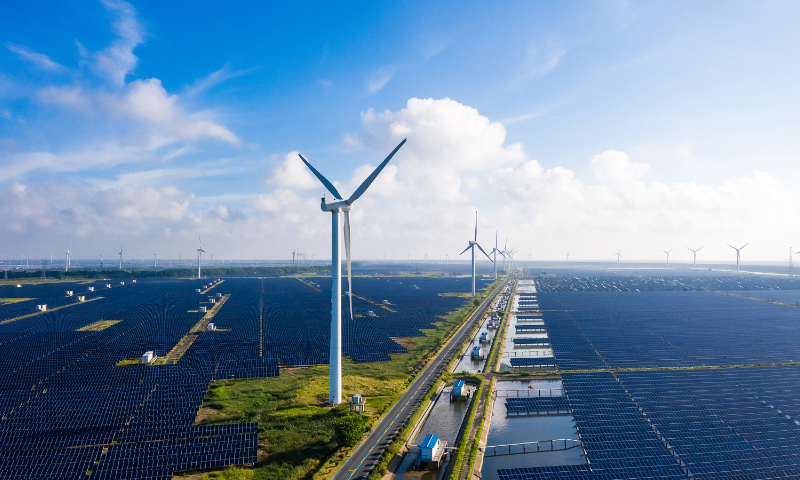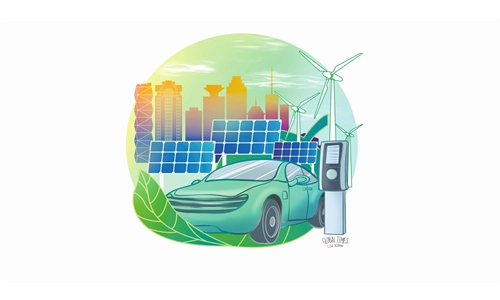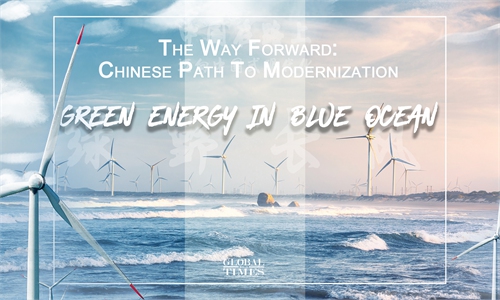
An electricity farm powered by wind and solar energy in Yancheng, East China's Jiangsu Province File photo: VCG
China has established the world's largest and most complete new-energy industry chain, an official of China's top economic planner said at an event on Thursday.
Zhao Chenxin, vice chairman of the National Development and Reform Commission (NDRC), made the remarks at an event commemorating National Ecology Day.
China has been the top producer of solar photovoltaic (PV) modules for 16 consecutive years, providing 70 percent of the world's PV modules and 60 percent of the global supply of wind turbines, Zhao said.
In the first half of 2024, China's new-energy vehicle (NEV) penetration rate reached 35.2 percent, ranking first among the world's major economies, according to Zhao.
Chinese analysts said that the achievements in the clean energy sector came after decades of effort to plan, build and invest in China's new-energy industries, amid the government's steadfast steering toward a green transformation of its economy and the active participation of Chinese companies of various ownership types.
They noted that China's status as home to the world's largest new-energy industrial chain will further maintain the stability and smooth operation of global energy industrial and supply chains, and promote the green and low-carbon transformation of the world.
In the meantime, huge demand for China's new-energy products around the world has erased any credibility of the "overcapacity" argument made by some in the West, analysts noted.
Sun Chuanwang, a professor at Xiamen University, told the Global Times on Thursday that the benefits of possessing the world's most developed industry chain can promote better coordination, integration and synergy among companies in all levels of the industry chain and push the overall competitiveness of industry players.
Globally, China's supply of new-energy products will ensure the stable development of the global green industry, and the nation's experience in forging such a complete supply chain can be a model for other countries to improve their own new-energy supply chain, Sun said.
The fact that China's new-energy supply chain keeps improving along with rising output shows that there is constantly growing demand for low-carbon products in the domestic and global markets, and that there is no overcapacity issue as suggested by some in the West, Sun said.
China has been one of the world's fastest economies in reducing energy intensity. In the first three years of the 14th Five-Year Plan period (2021-25), national energy intensity, excluding the energy used for raw materials and the consumption of non-fossil energy, fell by about 7.3 percent, said Zhao.
The NDRC official noted that China has the largest installed capacity of renewable energy in the world and the fastest development pace.
As the nation's green transformation gains pace, the clean energy sector has become a new driver for growth and investment.
Clean energy contributed a record 11.4 trillion yuan ($1.59 trillion) to China's economy in 2023, up 30 percent year-on-year, while clean-energy investment rose 40 percent year-on-year to 6.3 trillion yuan, according to data from the Helsinki-based Centre for Research on Energy and Clean Air.
In 2023, the export value of the "new three" industries of solar power, electric vehicles and batteries exceeded the 1 trillion yuan mark for the first time, with an annual growth rate of 29.9 percent, customs data showed.
The world's demand for Chinese new-energy products has remained strong.
In the first seven months of this year, NEV exports surged 17.8 percent year-on-year, data released by the China Passenger Car Association showed last week.
On August 11, the Communist Party of China Central Committee and the State Council unveiled guidelines designed to ramp up a green transition in all areas of economic and social development, calling on the country to achieve "remarkable results" in the green transition and the establishment of a green, low-carbon and circular development economic system by 2035.
By 2030, the scale of China's energy conservation and environmental protection industry will reach about 15 trillion yuan. The proportion of non-fossil energy will increase to about 25 percent of total energy consumption, and the installed capacity of pumped storage hydropower will exceed 120 million kilowatts.




